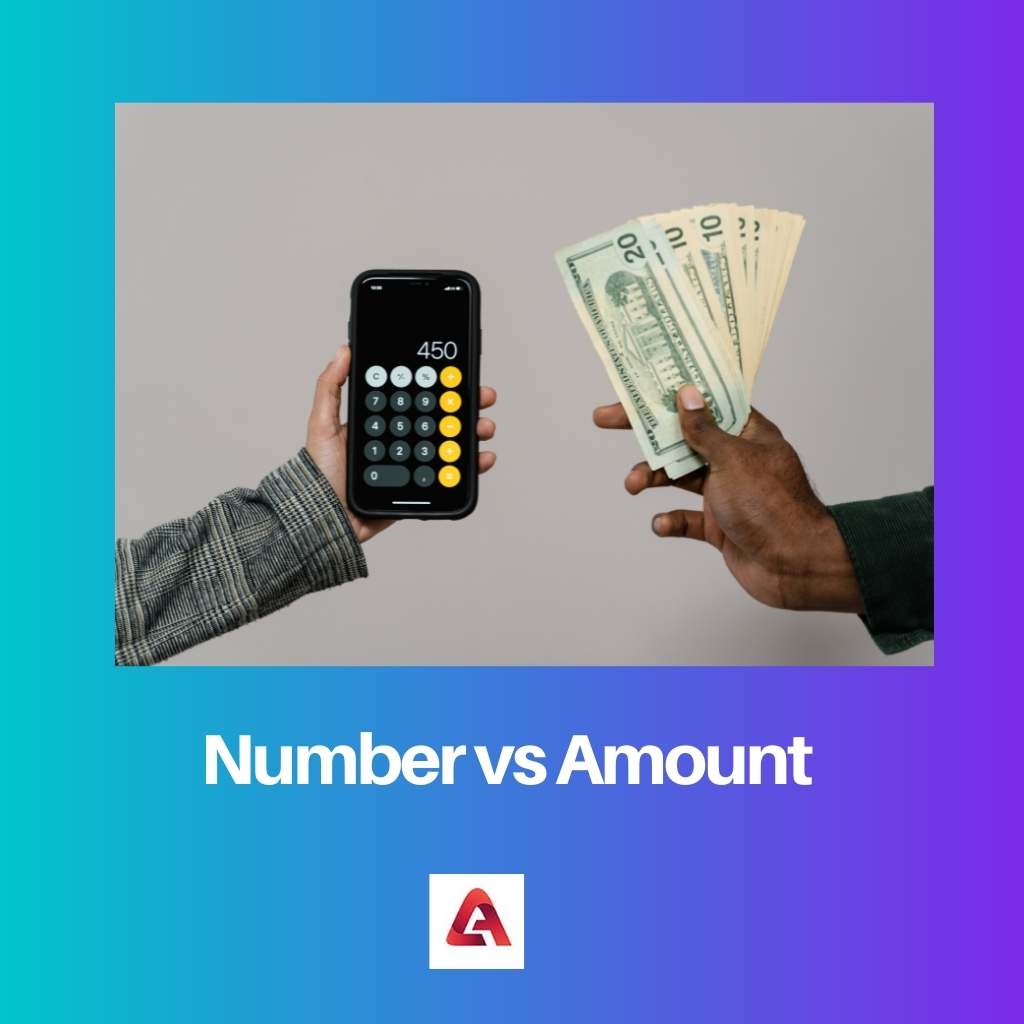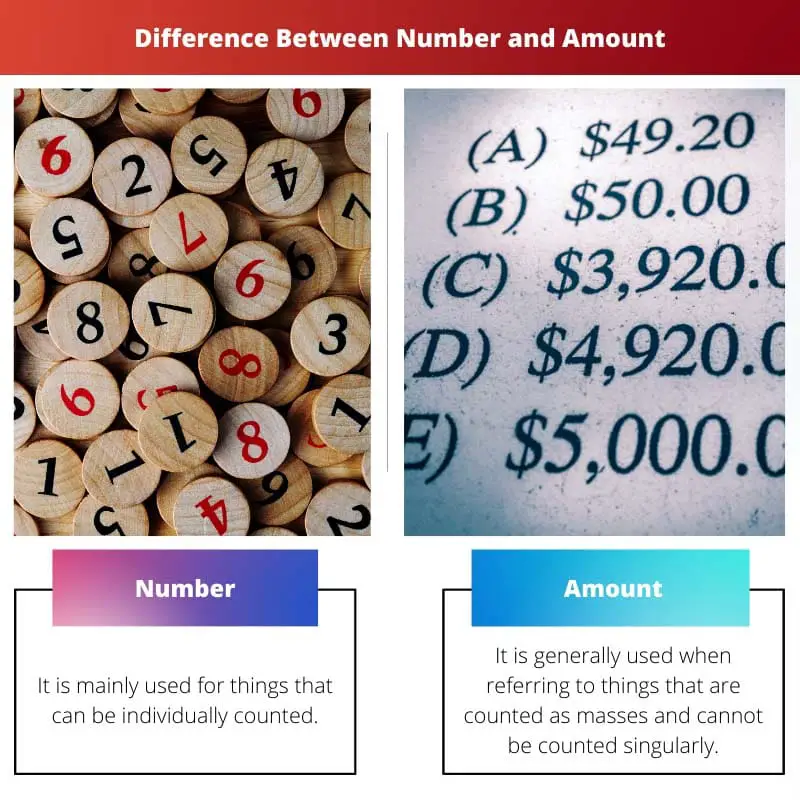Most people get a similar idea about Numbers and Amounts. Number and Amount refer to the same concept, but there is a little difference between the two.
The number is utilized for the things that can be counted (Countable Noun), whereas the Amount is used for the things which cannot exactly be counted (Uncountable Noun).
Key Takeaways
- “Number” describes a countable quantity of distinct items, while “amount” refers to an uncountable quantity or a mass of something.
- Use “number” with plural count nouns and “amount” with singular mass nouns.
- In mathematics, “number” represents a specific value or unit in a sequence.
Number vs Amount
The terms number and amount are used to describe quantity. The term “number” refers to a count of discrete units, such as the number of people in a room or the number of pages in a book. “Amount,” on the other hand, refers to a quantity that cannot be counted individually.

Number literally means countable nouns and things that can be counted. Numbers are also a set of characters such as 1, 2, 3, etc. The number is used for things that can be individually counted, like shoes.
Numbers can also be called Count Nouns. The number can also be used as a verb, for instance- The people at Travis’s concert must have numbered around thousands.
Amount implies mass count and mass nouns. These things cannot be exactly counted. They are not individually countable, so they are considered one as a mass.
For example – Sunlight, water, etc. The amount is not individually countable and considered one as a mass, so they can also be known as Non-Count Nouns / Mass nouns.
The amount can also be used as a verb as such- The Computer and the table amount too much.
Comparison Table
| Parameters of Comparison | Number | Amount |
|---|---|---|
| General Definition | It is mainly used for things that can be individually counted. | It is used when referring to things that are counted as masses and cannot be counted singularly. |
| Nouns | They are used for countable things so they are also known as Count Nouns. | They are not particularly used for counting individual things but as masses so they are known as Uncounted/Mass Nouns. |
| Example as Noun | Numbers can be used for counting the number of Clothes present. | The amount can be used to get an idea about the fabric used. |
| Usage as Verb | The number can be used as a verb where it means to count up or add up. | The amount can be used as a verb referring to become or equal to. |
| Example as Verb | The animals at the zoo number more than 200. | The expenses for maintenance of the Stadium amount to 10000$. |
What is a Number?
The term “number” refers to countable nouns and objects that can be tallied.
The application of numbers in daily life quantifies the items that can be counted as an individual using numbers like 1, 2, 3, 4, 5 and so on.
Numbers are made up of a series of characters such as 1, 2, 3, and so on. The number is used for items that can be numbered separately, such as shoes.
Count Nouns are another name for numbers. For example, the audience present in Travis’s show must have been counted in the thousands of numbers. It can be categorized into two groups:
Odd numbers: The odd numbers are those numbers that cannot be exactly divisible by the number two.
The examples of odd numbers from all the number ranging between 0-10 are 1, 3, 5, 7, 9.
Even numbers: Even numbers are those numbers that can be fully divisible by the number 2, leaving no remainder behind.
The examples of even numbers from all the number ranging between 1-11 are 2, 4, 6, 8, and 10.

What is the Amount?
The amount is a term used for the quantifying purpose, which means it is used to quantify some things which cannot be counted using numbers. The term “amount” is considered as a mass count and mass noun.
These objects are impossible to count precisely or use with numbers.
The reason behind that is they can’t be counted separately or individually as they’re lumped together as a mass or of very small size, which is not possible to count in numbers.
For instance, sunlight, water, rice, and so on. They are also known as Non-Count Nouns / Mass Noun phrases since they are not separately countable and are regarded as one as a mass.
The amount can also be used as a verb: The computer and table amount a lot for someone whose salary is limited.
The term can also be used to indicate the sum or total of money. For example, a person is asked to pay the left amount in a specific time of money.
It can also be used to quantify space, feeling, time, or substance. For example, all the solutions provided take plenty of time for execution.

Main Differences Between Number and Amount
- The number is a term that refers to things that can be counted as individuals, whereas the Amount is used for the things that are considerably counted as masses and not possible to be counted as singularly.
- Numbers are technically used for all the countable things, so that’s why they are also known as Count Nouns, whereas amounts are not particularly used for counting individual things but rather used as masses, so that’s they are known as Uncounted/Mass Nouns.
- In Nouns, the examples would be as Numbers, which can also be used to count the number of clothes present, whereas Amounts can be used to get an idea about the fabric used.
- The number can also be seen as a verb that means to count up or add up, whereas the Amount seems to be used as a verb referred to as to become or equal to.
- For example, the number as a verb can be seen as The number of animals at the zoo is more than 200, whereas the amount as a verb can be seen as the expenses of maintenance of a reputed stadium amounting to 10000$.

References
- https://books.google.co.in/books?hl=en&lr=&id=njgVUjjO-EAC&oi=fnd&pg=PP1&dq=number&ots=cmf4VXkuq3&sig=dyAejJ29NfBTcw2VsJRdIU3otc8&redir_esc=y#v=onepage&q=number&f=false
- https://books.google.co.in/books?hl=en&lr=&id=s1vsCAAAQBAJ&oi=fnd&pg=PR17&dq=number&ots=wXw9HvYFLe&sig=MeSYBU1Wb1Hly7Z85PI7HCNeUQM&redir_esc=y#v=onepage&q=number&f=false

This post provides an excellent explanation of the differences between numbers and amounts.
The post is very informative and clearly outlines the distinctions between number and amount.
I just can’t get over the absurdity of debating the intricacies of number versus amount in the English language!
It is fascinating to see the difference so clearly explained in this post.
It sure is, isn’t it?
I would argue that the distinction between number and amount is quite trivial, but interesting nonetheless.
The table comparing number and amount is particularly helpful for distinguishing the two concepts.